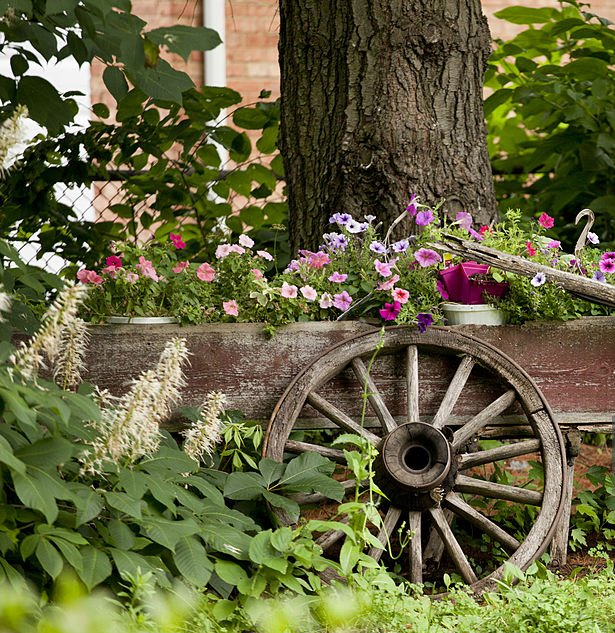
How to Create a Rustic Garden Oasis: A Guide to Charm, Character, and Climbing Vines
There’s something magical about a rustic garden. It feels timeless, welcoming, and effortlessly beautiful—like a secret hideaway where nature and creativity collide. Whether you’re a seasoned gardener or a beginner with a dream, creating a rustic garden is all about embracing imperfections, repurposing everyday objects, and letting nature take the lead. And what’s more rustic than a weathered metal trellis, slowly developing a patina of rust as climbing plants weave their way up? Let’s dive into how you can create your own rustic garden paradise, complete with a touch of vintage charm.
Step 1: Start with a Vision (But Keep It Loose)
A rustic garden isn’t about perfection—it’s about character. Imagine a space that feels lived-in, where every object tells a story. Think wildflowers, weathered wood, and a mix of textures and colors that blend seamlessly with the natural environment. Don’t overthink it; let your garden evolve organically.

Step 2: Repurpose Common Garden Objects
One of the hallmarks of a rustic garden is the use of everyday items in creative ways. Here are some ideas to get you started:
-
Old Wooden Crates or Pallets: Turn them into planters for herbs, flowers, or succulents. Stack them for a tiered effect or lay them flat for a raised bed.

-
Vintage Tools: Hang an old rake, shovel, or watering can on a fence or wall as decorative accents. They add instant rustic charm.
-
Mismatched Pots and Containers: Use chipped ceramic pots, tin buckets, or even an old wheelbarrow as planters. The more weathered, the better!
-
Stone Pathways: Scatter irregularly shaped stones or bricks to create a meandering path through your garden. It’ll feel like you’re walking through the countryside.
-
Rustic Furniture: Add a wooden bench or a pair of Adirondack chairs. If they’re a little worn, even better—they’ll fit right in.

Step 3: Introduce a Rustic Metal Trellis
Now, let’s talk about the star of the show: a rustic metal trellis. This is where your garden gets vertical interest and a touch of industrial charm. Here’s how to make it work:
-
Choose the Right Metal: Opt for untreated steel or iron. Over time, it will develop a natural rust patina, adding to the rustic vibe. You can find pre-made trellises at garden centers or DIY one using rebar or steel mesh.

-
Placement Matters: Position your trellis against a wall, fence, or as a freestanding structure in the middle of your garden. It’s perfect for climbing plants like roses, clematis, ivy, or even vegetables like beans and peas.
-
Let It Rust: Don’t fight the rust—embrace it! The patina that forms over time will give your trellis a unique, weathered look that blends beautifully with the natural elements of your garden.
-
Plant Companions: Surround the base of your trellis with low-growing plants like lavender, thyme, or daisies to create a lush, layered effect.
Step 4: Go Wild with Plants
A rustic garden thrives on a mix of structured and wild elements. Here’s how to choose the right plants:
-
Climbers: As mentioned, climbing plants are perfect for your trellis. Think wisteria, jasmine, or honeysuckle for a fragrant touch.
-
Wildflowers: Scatter seeds for poppies, cosmos, or black-eyed Susans. They’ll add pops of color and attract pollinators.

-
Herbs: Rosemary, sage, and oregano not only look great but are practical too. Plant them in repurposed containers or along pathways.
-
Foliage: Incorporate plants with interesting textures, like ferns, hostas, or lamb’s ear. They add depth and contrast to your garden.
Step 5: Add Finishing Touches
The little details are what make a rustic garden feel complete. Here are some ideas:
-
String Lights: Drape fairy lights or vintage-style bulb strings around your trellis or across your garden for a magical evening glow.
-
Birdhouses and Feeders: Hang a few birdhouses or feeders to invite wildlife into your space. Bonus: They add to the rustic aesthetic.
-
Garden Art: Incorporate handmade or found objects, like a mosaic mirror, a rusty old wagon wheel, or a whimsical sculpture.

-
Water Feature: A small, weathered fountain or a DIY birdbath can add a soothing element to your garden.
Step 6: Let Nature Do Its Thing
The beauty of a rustic garden is that it doesn’t need to be pristine. Allow plants to spill over pathways, let moss grow on stones, and don’t worry if things look a little wild. Over time, your garden will develop its own personality, with your rustic metal trellis as the centerpiece, aging gracefully alongside the plants it supports.
Final Thoughts
Creating a rustic garden is like telling a story—one that evolves with time, weather, and care. It’s a space where imperfections are celebrated, and every element has a purpose. So grab those old crates, let that metal trellis rust, and watch as your garden transforms into a cozy, enchanting retreat. Remember, the best rustic gardens are the ones that feel like they’ve been there forever, even if you just planted the first seed yesterday. Happy gardening! 🌿✨
